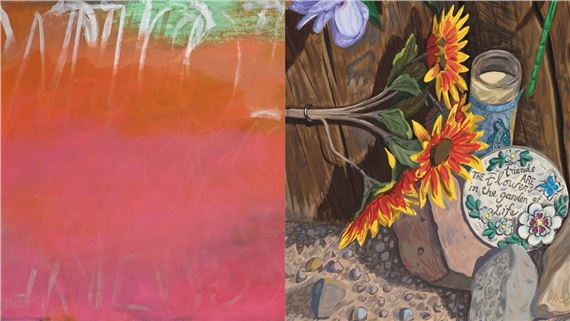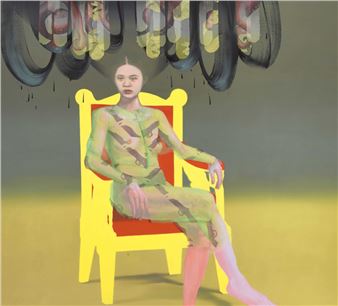Dana Frankfort and Josephine Halvorson: Seeing and Reading
Dana Frankfort and Josephine Halvorson explore the role of text in painting — its potential as both language and image. Their approaches diverge sharply: Frankfort invents language on the canvas, while Halvorson discovers it in the world.
Frankfort’s energetic works feature single words or phrases painted in gestural, layered washes of color. But legibility is not the point — her letters dissolve into painterly marks, blurring the line between reading and seeing. Frankfort's use of language is emotional, open-ended, and performative; words become shapes, tones, and even moods. Working primarily in oil, she embraces the medium’s viscosity and unpredictability — dragging, layering, and scumbling the surface into what Halvorson once described as “the prettiest mud you’ve ever seen” in a press release for Frankfort’s 2023 show at Olympia in New York. Frankfort has likened her paintings to landscapes — vast, weathered spaces shaped by color, gesture, and atmosphere. Her words drift like clouds, hovering at the edge of meaning and visibility.
Halvorson, by contrast, paints at the scale of encounter. Her subjects are observed on-site — objects and surfaces that bear the traces of time, labor, and use. A collapsed wooden sign with fragmented lettering, a rusted potbelly stove partially obscured by encroaching plants, or a carved 18th-century tombstone where autumn leaves have gathered at its base: she renders each with fidelity and care, capturing not just what the object says but how it has aged, weathered, and endured. If Frankfort’s paintings evoke the atmosphere of the horizon, Halvorson’s are made at arm’s length; both offer a kind of landscape, but from entirely different vantage points. Working with acrylic gouache on absorbent grounds — materials inspired by fresco painting — Halvorson preserves the immediacy of each brushstroke and the shifting effects of daylight. Her works are portraits of presence, marked by deep attention to material, time, and mortality.
Together, Frankfort and Halvorson reflect on what it means to look, read, and interpret. Whether text is conjured in the studio or found in the field, each artist shows that words as images carry not just meaning — but memory, place, and feeling.

Recommended for you
Dana Frankfort and Josephine Halvorson explore the role of text in painting — its potential as both language and image. Their approaches diverge sharply: Frankfort invents language on the canvas, while Halvorson discovers it in the world.
Frankfort’s energetic works feature single words or phrases painted in gestural, layered washes of color. But legibility is not the point — her letters dissolve into painterly marks, blurring the line between reading and seeing. Frankfort's use of language is emotional, open-ended, and performative; words become shapes, tones, and even moods. Working primarily in oil, she embraces the medium’s viscosity and unpredictability — dragging, layering, and scumbling the surface into what Halvorson once described as “the prettiest mud you’ve ever seen” in a press release for Frankfort’s 2023 show at Olympia in New York. Frankfort has likened her paintings to landscapes — vast, weathered spaces shaped by color, gesture, and atmosphere. Her words drift like clouds, hovering at the edge of meaning and visibility.
Halvorson, by contrast, paints at the scale of encounter. Her subjects are observed on-site — objects and surfaces that bear the traces of time, labor, and use. A collapsed wooden sign with fragmented lettering, a rusted potbelly stove partially obscured by encroaching plants, or a carved 18th-century tombstone where autumn leaves have gathered at its base: she renders each with fidelity and care, capturing not just what the object says but how it has aged, weathered, and endured. If Frankfort’s paintings evoke the atmosphere of the horizon, Halvorson’s are made at arm’s length; both offer a kind of landscape, but from entirely different vantage points. Working with acrylic gouache on absorbent grounds — materials inspired by fresco painting — Halvorson preserves the immediacy of each brushstroke and the shifting effects of daylight. Her works are portraits of presence, marked by deep attention to material, time, and mortality.
Together, Frankfort and Halvorson reflect on what it means to look, read, and interpret. Whether text is conjured in the studio or found in the field, each artist shows that words as images carry not just meaning — but memory, place, and feeling.

 ARTISTS
ARTISTS













